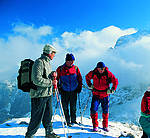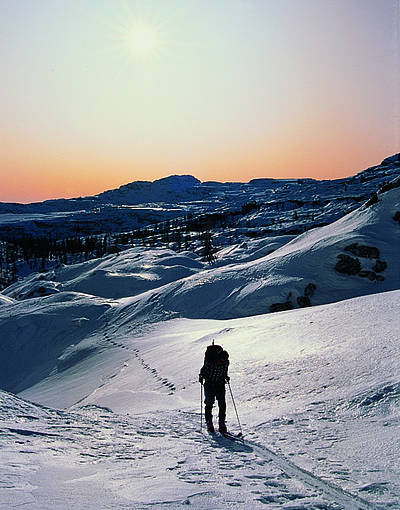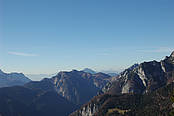The Tricorno Park

The Tricorno National Park surrounds the highest peak of the Slovenian Julian Alps, towering imposingly over the Vrata Valley. The great, majestic domed summit, which is visible from most of the other Julian peaks, is best viewed from Sella Sovatna, the pass separating the Kriz and Stenar mountains from Bovski Gamsovec. The Tricorno has an important place in ancient Slovenian mythology. Its Slovenian name Triglav, meaning Three Heads, refers not to its shape, but to the lord of water, air and earth. Many legends are associated with it, such as the story of Zlatorog, the mythical ibex with the golden horns, published in 1868 by Karl Deschmann at Ljubljana.
The first ascent to the summit was made by Lorenz Willonitzer, Rozic, Matthaus Kos and Lukas Koroscek in 1778. "...They left from Bejo Polje at dawn on 26 August. Travelling first to the left, and then in a diagonal line from south west to north east, they reached Suhi Plas in five hours, from where Willonitzer, a surgeon, claimed to have spotted the Laibach Plain and the Mojstrana Valley. He wrote to Baron Zois that it was a dreadful sight to look down into that terrifying abyss. The long-lying snow appeared green to his eyes, and he also noticed a gushing spring from which the water emerged with a great roar. The climbers left the grassy clearing and made their way up westbound to the Krederza ridge, arriving below the last horn of Triglav in little more than an hour. It seems that the path, at some points, was no wider than a pair of shoes, and had a surface of splintered rock fragments. Willonitzer and his companions paused when they reached the third horn. They estimated that they could arrive at the summit in three quarters of an hour and, after gathering their spirits, eventually reached it along the crest of the northern ridge. They were fortunate to meet favourable weather, with no wind and bearable cold temperatures. Willonitzer found that the summit was wide enough to accommodate around thirty people. There was no sign of previous human visitors..."
This was the account of a contemporary of these first climbers.
Julius Kugy, renowned as a botanist, climber and writer, made his first ascent in 1875, and made the first climb of the west face in 1881.
The carsic basin between the crest and the flanks of the north wall once contained a small glacier, now much reduced in size.
From Rudno Polje (1345 metres), near a barracks building, climb the track up to the ski lifts. A little further on, take the path which rises up Zlata Voda, through some rather steep stretches, to Studorski Preval (1892 metres) (h 2).
From here you descend a little and then proceed along a level stretch to the Vodnikov Dom refuge (1817 metres) (h 1/ 3).
Follow a path crosswise to Konjski Preval (2020 metres). Leave the path to the left that leads to Dom Planika, and head upwards. You soon reach another fork. Turn left off the path to Kredarica, and continue northwest on a path (with protected stretches) to Triglavski Dom (2515 metres), the highest Alpine refuge in Slovenia (h 2.30). Take the short descent to the pass, which is the starting point of the climb (on scree and rock provided with rungs, steps, and some sections with cable assistance) leading to Mali Triglav – Piccolo Tricorno (2725 metres). You now follow a very exposed crest – sometimes called the porcupine’s back - that is equipped with cable assistance and leads to the summit with its characteristic little metal tower (h 1.15/6.15).








